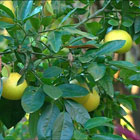This week, rather than choosing just one plant, Don looked at the entire citrus family. No Australian backyard is complete without at least one citrus tree!
Citrus trees have glossy, evergreen leaves and fragrant white flowers in spring. The flowers are followed by fruit that is both attractive and nutritious. One of the best things to do to reduce your chances of getting colds is to eat more citrus fruit such as lemons, oranges, grapefruit and mandarins. They contain vitamin C and they are a good source of bioflavonoids, which prevent vitamin C being destroyed by oxygen.
Citrus trees don’t require a lot of attention throughout the year. They can be virtually neglected, and still weigh down their branches with fruit, season after season. Most children love citrus fruit, particularly mandarins.
Best citrus varieties
Lemon
The ‘Eureka’ lemon is great for the warmer areas of Australia, while ‘Lisbon’ or ‘Meyer’ lemons suit cooler climates. Of all varieties, the ‘Meyer’ is the best choice for planting in a tub in any climate.
Orange
While many people love the taste of ‘Navel’ orange juice, the seedless ‘Valencia’ is also great for juicing and has fewer problems. It is the better growing tree for backyards as it crops over a longer period.
Mandarin
Mandarins are fast health food – they peel easily and cleanly and their sweetness makes them a great favourite with kids. Of all the citrus trees, the ‘Emperor’ mandarin would be the finest addition to your backyard.
Grapefruit
‘Marsh’ is a popular and very productive cultivar. It bears pale yellow, rounded fruit in early winter and spring.
Lime
‘Tahiti’ produces very juicy fruit, and is used in drinks or as a lemon substitute. The seedless fruit is small and green when ripe.
Cumquat
The ‘Nagami’ cumquat with its oval-shaped fruit has a sweeter taste than other cumquats and is very decorative on the tree. Another good container plant for a small garden.
Citrus tips
Plant in full sun.
Before planting, dig in plenty of chook, cow or horse manure into the ground.
Citrus will grow in most parts of Australia, except for mountain areas. Protect from frost when young.
Ideally, citrus growing in the ground should be fertilised in August and February. It is good to alternate fertilisers – say Dynamic Lifter in August/September and complete citrus food in February. Fertilise potted citrus every six to eight weeks with a complete citrus food alternated with Dynamic Lifter, or use a slow release fertiliser such as Osmocote for pots.
Keep citrus trees well watered when young fruit is forming in spring and early summer.
Deep water trees once or twice a week in the warmer months. (Note: check your local water restrictions.)
Grass and citrus don’t mix. Keep the area beneath your citrus free of grass and weeds.
Cover with a mulch such as lucerne, composted leaf litter or compost, but keep the mulch away from the tree trunk to avoid collar rot.
It is not necessary to prune citrus to produce fruit. However, the trees can be pruned if it is necessary to shape them in some way, for example to remove low hanging branches, or to remove branches that are rubbing and can cause bark damage and allow an entry point for disease. Citrus may also require pruning if too heavy a crop is produced.
Try incorporating some citrus trees and chooks in your backyard to create a mini ecosystem, and a great source of interest for your kids. In Don’s own garden he has planted citrus trees next to the chook shed. The tree roots have grown under the shed to get at the continuous supply of rich chook manure. Additionally, the chooks act as mobile compost heaps, devouring all the kitchen scraps and adding manure to the soil.
Further information
Citrus trees are available in fruit now at your local nursery.



